Disclaimer & Copyright Notices; Optimized for the MS Internet Explorer
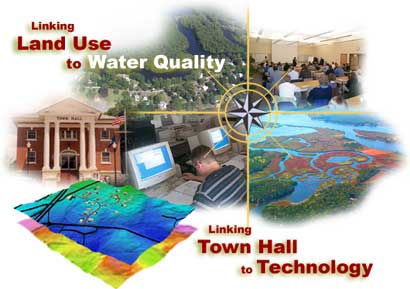
Formal submission to the RP+5 initiative of the HRM
Soil & Water Conservation Society of Metro Halifax (SWCSMH)
May 16, 2012 
Reference: RP+5_Submission2012april17
(revised); Note: Even with the upgrading of this submission as needed
in order to expand the scientific component in limnology, environmental
microbiology, and related specialties, the 15 prime recommendations
never changed. In addition, they are very similar to those that we made
to the Regional Plan during years, 2004 to 2006, and to the SEMO, HRM in May, 2011.
Contents:
(Note: We are providing several web links as
underlined words rather than our usual practice of a subtle change in
colour when one hovers the mouse over them. In this manner, the web
links are clearly visible to be clicked upon.)
- Introduction (see also Section-L)
- Our fifteen (15) prime recommendations which fall under the domain of sound Governance and science-based watershed management:-
- Set up a Lakes Authority at HRM staffed with two (2) qualified, preferably `applied limnologists’.
- HRM’s paid consultant studies:-
Provide the names of all the authors, their formal qualifications,
credentials, and any independent international citations they received
as `appendices’ in the studies.
- Impart top priority to scientific monitoring
and related studies. Should be carried out by eminently qualified
Government officials (inhouse if possible) and/or in partnership with
leading scientists in the relevant disciplines as follows:-
- Biological monitoring and comprehensive sampling.
- Scientific definition of trophic status. Government officials and their consultants may be making significant errors.
- Paleolimnology has been ignored in HRM to date. Hence, several
erroneous conclusions may have emanated from HRM and/or from its
consultants.
- Lake water sampling and the
futility in tracking the incremental impacts of new developments,
especially in shallow and/or coloured lakes which could be macrophyte
driven.
- The CCME's (2004) policy on cultural eutrophication should be strictly adopted by HRM as a regulatory tool.
- HRM’s major shortcomings w.r.t the threshold TP values of Lakes Russell, Morris, Kearney, and Papermill.
- Carry out DNA fingerprinting
before making public statements on the fecal sources. HRM and Halifax
Water have been making unscientific comments on fecal sources without
carrying out scientific DNA analyses.
- Mandate total stormwater treatment systems
capable of removing the myriad of post-development stressors, not
silt/soils and phosphorus alone, in new major developments. Such
systems also need regular maintenance as needed to be effective:
- Some examples of the post-development stressors/pollutants as well
as treatment efficiencies of typical in-situ systems are included in Section-F.
- Buffer Strips, sound technical
sizing, and protection in perpetuity; and do not allow walkways to be
constructed within such buffers (see also Section-G).
- Septic systems: abandon the
negative impressions. But in new developments, aim for greater setbacks
(than required by provincial guidelines) from lakes to prevent nutrient
enrichment over multi–decadal time scales (see Section-H for further
details).
- Advanced assessments by qualified limnologists
have to be carried out on sewage treatment plants (STPs) prior to their
construction and/or to establish the need for upgrading.
- Shallow Lakes: Kindly take
into account that the limnology of shallow lakes can be quite different
from deep lakes. Most standards and other aspects are based on research
on deep lakes.
- Investigate the endocrine disrupting compounds (EDCs) in the effluents of sewage treatment plants (STPs) discharging into lakes and rivers.
- Enforce the Halifax County’s Topsoil Removal Bylaw
of allowing a maximum 50 mg/l of suspended solids in any grab sample at
the outlets of all new developments which should include even
residential developments.
- Enact a Lawn Fertilizer Bylaw
restricting use of phosphorus containing fertilizers similar or
superior to the City of Minneapolis as extensively noted by the UNEP’s
committees.
- Implement `Indicator thresholds for anthropogenic stressors of freshwater lakes in Nova Scotia’ as one of the tools for assessing lake water quality.
- Chemical vs Biological monitoring in limnology and comprehensive sampling.
- Scientific definition of trophic status and Government officials and their consultants may be making significant errors.
- The importance of paleolimnology.
- Stressors and treatment efficiencies.
- Buffer Strips:
- Canada's interim narrative on regression analysis between stream buffer widths and average TN and TP concentrations.
- Monitoring of the effluent plume from an onsite sewage disposal system.
- A lead example of the methodology to assess the downstream impacts of a proposed STP.
- Shallow Lakes.
- Sandy Lake model with field data (4th vers.).
- Additional info on us.
A. Introduction (see also Section–L)
There are fifteen (15) focused
recommendations enunciated in Section–B for the HRM to implement
without any further delay. Sections C-to-L inclusive provide basic
scientific rationale. We provide web links primarily to our web sites.
We sincerely apologize for any
omissions or typos/grammar in this submission although it has been peer
reviewed over time. To a degree, this submission is being made on an
informal basis though the `science' cited here has been extensively
published.
This submission is quite
similar to previous submissions that we had made to various initiatives
of not only the HRM but also of its former municipal units. Kindly
access our related website, Submissions relating to Applied Limnology vis-a-vis land planning/development, and Submissions to HRM's Regional Planning process.
We are an independent
scientific society specializing in the biotic integrity and
biodiversity of freshwaters and parts of the marine ecosystems with
emphasis on phytoplankton, zoobenthos, phytobenthos, chironomid mentum
deformities, and predictive modelling utilizing a range of published
models and parameters (not phosphorus alone) worldwide. We are getting
involved in paleolimnology as well, albeit at a lower pace.
Among our scientific
directors, we count some of the leading worldwide scientists primarily
in the domain of formal limnology, environmental microbiology,
paleolimnology, and to some degree, sanitary engineering.
Among our 400 associates
worldwide, 200 are domiciled across Nova Scotia, majority of the latter
being across HRM in diverse communities. We do have professionals from
other disciplines as well.
B.
Our fifteen (15) prime recommendations which fall under the domain of
sound Governance and science-based watershed management:
Set up a Lakes Authority at HRM staffed with two (2) qualified, preferably `applied limnologists’:
Such an `authority’ should be mandated to restore lakes on a pragmatic
level following consultations with all stakeholders, and not just with
political appointees.
Examples of recent failures were the severe impacts on Sandy Lake, Hammonds Plains in the Glen Arbour area of the Sackville River watershed, and at Russell Lake, Dartmouth of the Cow Bay River watershed.
While the subsequent pelagic sampling of Sandy Lake shows the TP
values may have returned to lower levels, nonetheless, there may be
signs of some impacts to the ecosystem of the lake (see Section-K).
Of lately, increased nuisance algal blooms, on occasions, have
been observed at some lakes, mostly in the urban/serviced areas.
Strangely enough, we have not observed these in rural lakes so far.
This is based on the lakes that we studied the phycology of to date.
Not all cases have been `bad news stories’ though. Among numerous cases are the following:
We have observed considerable improvement in some lakes and
cases like McGrath Lake in Terence Bay of the Terence Bay River
watershed are a prime example of success stories.
At Maynard Lake, Dartmouth, as a result of multi-year community
action, considerable reduction in bacteriological impacts has been
noted. The biodiversity and the biotic integrity of the zoobenthos have
been very encouraging based upon international protocols.
HRM’s
paid consultant studies:- Provide the names of all the authors, their
formal qualifications, credentials, and any independent international
citations they received as `appendices’ in the studies:
All studies should be placed on HRM’s website without any delays.
It is further necessary to insist on studies by authentic
limnologists, whether theoretical and/or applied, where the issues
being addressed have a direct relevance to freshwater quality, i.e.,
lakes, ponds, rivers. Overall, this is not a formal specialty of the
traditional engineering and planning domains.
Impart
top priority to scientific monitoring and related studies. Should be
carried out by eminently qualified Government officials (in-house if
possible) and/or in partnership with leading scientists in the relevant
disciplines as follows:
- Biological monitoring and comprehensive sampling (see Section-C).
- Scientific definition of trophic status. Government officials and their consultants may be making significant errors (see Section-D).
- Paleolimnology has been ignored in HRM to date. Hence, several
erroneous conclusions may have emanated from HRM and/or from its
consultants (see Section-E).
By ignoring the all important biological limnology, the majority of
studies carried out to date for the HRM as well as for its former
municipal units may have failed to accurately describe the symptoms and
prevent the problems.
Important: Further, HRM has failed to take into account the `biological availability’ of different species of phosphorus.
Lake
water sampling and the futility in tracking the incremental impacts of
new developments, especially in shallow and/or coloured lakes which
could be macrophyte driven (also see Section-J).
Further, to reliably ascertain incremental inputs from new
developments, outflows of major storm pipe outlets, in-situ devices
(e.g., CDS, Stormceptor, Vortechnics), constructed wetland outlets,
have to be monitored regularly, and pollutographs have to be developed.
Neither HRM nor its consultants have ever carried out this
necessary sampling as far as we can fathom. We apologize if we are in
error. We respectfully request that HRM make those results available to
the public via its web sites without any red tape.
The CCME's (2004) policy on cultural eutrophication should be strictly adopted by HRM as a regulatory tool (also see Section-D)
This
policy is nothing new since the relevant science in it has been known
from as far back as the 1980’s to scientists who are `current’ in
research.
As the year-2004 CCME Policy on Phosphorus (TP) clearly narrates
that, not adhering to the reference/background (i.e., the pre-cultural
value) + 50% maximum increase concept, even if they fall within the
reference trigger ranges, could result in significant changes to the
`community structure'.
- HRM’s major shortcomings w.r.t the threshold TP values of Lakes Russell, Morris, Kearney, and Papermill:-
The HRM had made significant errors in assigning high threshold TP
values of 15 µg/l for Russell and Morris Lakes, and 10 µg/l
for Kearney and Papermill Lakes. HRM’s deductions were out of line with
the scientific thought even then. HRM does not appear to have
ascertained the pre-cultural concentrations based on either predictive
models and/or on paleolimnological inference models.
Further, HRM has failed to take into account the `biological availability’ of different species of phosphorus.
The Province of Quebec has a formal policy in line with what we stated.
The Province of Ontario has been planning to adopt same but has been delayed.
Hence, there are precedents in Canada. Incidentally, the CCME as
well as the Quebec standards are the direct application of the Ontario
research headed by Prof. Dr. Peter J. Dillon who is also a Scientific
Director of our group.
The Swedish Government endorses a maximum of twice the background levels of phosphorus and nitrogen as a national target.
Select References:
- Holdren, C., Jones, W., and Taggart, J. 2001. Managing Lakes and
Reservoirs. N. Am. Lake Manage. Soc. and Terrene Inst., in coop. with
Off. Water Assess. Watershed Prot. Div. U.S. Environ. Prot. Agency,
Madison, WI. xiv, 382 pp.
- Scott, R., Hart, W., Mandaville, S., and Lowe, J. 2003.
Selection of a Phosphorus Loading Model for Nova Scotia, Phase I. For:
Nova Scotia Water Quality Objective and Model Development Steering
Committee and Nova Scotia Dept. of Environment and Labour. 85p.
- Soil & Water Conservation Society of Metro Halifax: Lake Carrying Capacities
- Soil & Water Conservation Society of Metro Halifax: TP/Cha Predictive Models
- The Province of Quebec: Phosphorus standards
Carry out DNA fingerprinting before making public statements on the fecal sources:
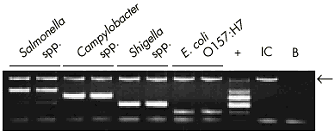 Bacterial
Source Tracking (BST) is a state-of-the-art methodology that is being
used in advanced jurisdictions to determine the sources of fecal
bacteria in environmental samples (e.g. from human, livestock, or
wildlife origins). BST methodology has been described as having the
ability to turn nonpoint sources into point sources. BST is also called
Microbiological Source Tracking (MST), fecal source tracking, or fecal
typing.
Bacterial
Source Tracking (BST) is a state-of-the-art methodology that is being
used in advanced jurisdictions to determine the sources of fecal
bacteria in environmental samples (e.g. from human, livestock, or
wildlife origins). BST methodology has been described as having the
ability to turn nonpoint sources into point sources. BST is also called
Microbiological Source Tracking (MST), fecal source tracking, or fecal
typing.
Fecal contamination of aquatic environments afflicts many regions
and may carry risks to human health. For example, human fecal pollution
may spread dangerous bacterial and viral pathogens, such as hepatitis,
while other human pathogens such as Cryptosporidium parvum, Giardia
lamblia, Salmonella spp., and E. coli O157:H7 are associated with
animal fecal pollution.
Further, contamination of coastal and inland waters by fecal
bacteria results in beach closures that suspend recreation and strike a
blow to the economies of beach communities.
Often the source of fecal contamination in water cannot be
determined. For example, non-point sources such as failing septic
systems, overloads at sewage treatment facilities, overflows from
sanitary sewage pumping stations, or flows from sewage pipe breaks may
all be candidates. In addition, the contribution of bacterial pollution
"stored" in sediments and re-suspended during storm events is unknown.
In order to adequately assess human health risks and develop watershed
management plans, it is necessary to know the sources of fecal
contamination.
See our web page for more info.
Also read the following synopses carried out for the EMS Department:
Mandaville, S.M. 2002. Bacterial
Source Tracking (BST)- A Review. Project H-2, Soil & Water
Conservation Society of Metro Halifax. X, 46p., Appendices A to T.
Mandate
total stormwater treatment systems capable of removing the myriad of
post-development stressors, not silt/soils and phosphorus alone, in new
major developments. Such systems also need regular maintenance as
needed to be effective:
Access our web page on stormwater treatment systems.
- Some examples of the post-development stressors/pollutants as well
as treatment efficiencies of typical in-situ systems are included in Section-F.
An example of a treatment system is depicted below although it is
not guaranteed to remove all incremental stressors in perpetuity. Costs
have to be borne by a proponent and/or shared by levels of Government.
The origin is a handbook of Monash University, Australia:
In an extreme case, HRM has to insist on the installation of
lakeshore interceptors of all storm discharges and treat them in a
modified sewage treatment plant prior to discharge into any freshwater
courses. Costs may have to be borne by the prime beneficiaries, i.e.,
the proponents of any incremental developments. A basic example of such
a treatment is:-
Buffer
Strips, sound technical sizing, and protection in perpetuity; and do
not allow walkways to be constructed within such buffers (see Section-G).
Buffer strips do not remove any appreciable amount of pollutants
entering lakes via stormwater discharges. But they could be of some
value only if they are maintained in their natural state in perpetuity.
We request that HRM enact a bylaw where walkways are wholly banned
in buffer strips even if the local community supports such walkways.
Pollution does not discriminate between developers and the general
public.
The sizing of buffers has to be based on technical factors
which have to include at the least, slope of the land, K (soil
erodibility index), and RCN (Runoff Curve Number). The USDA had
developed a regression analysis based on these parameters. We have not
tested the efficacy in Nova Scotia yet (see Section-G for details).
The Regional Plan’s emulation of the standards of the NS Dept.
of Natural Resources of 20 metres is not based on science and is only a
generality.
Alternately, follow the precautionary approach as recommended
in research by Environment Canada, and legislate a minimum buffer of
one hundred (100) metres around lakes and rivers, where possible, for
the long term protection (Section-Gi).
A `buffer’ also implies that no walkways be built on them either.
Septic
systems: abandon the negative impressions. But in new developments, aim
for greater setbacks (than required by provincial guidelines) from
lakes to prevent nutrient enrichment over multi-decadal time scales
(see Section-H)
The past and many of the present problematic systems may have been in areas served with what are known as “area beds”.
Since around the late-1980s in Nova Scotia, the “CONTOUR SYSTEMS”
have become the norm in most cases areas where there is a slope to the
land.
The contour systems basically involve `lateral spread of the
effluent plume’ and utilize the reduction capacity of the whole
downstream site as opposed to the old `area beds’ which utilized only
the area immediately underneath the bed.
Engineering scientist, David Pask MEng PEng
was the inventor/developer of contour systems at TUNS in 1983. His
primary supervisor was the now retired Prof. Dan Thirumurthy PhD PEng,
and there were several other professors with varied expertise who also
assisted David. David is also an associate of our group.
Several studies conducted for the HRM and for the former
Halifax County as well as for the Province may have made unscientific
assumptions wherein they assumed 50% export of phosphorus from septic
beds to the nearest watercourse. There has never been any research
conducted to support this.
Incidentally, our own former predictive models also made the same assumption. We are modifying the models as we find time.
The sampling methodology utilizing piezometers and lysimeters
has to be undertaken at statistically valid number of onsite systems
for monitoring of the effluent plumes before one can establish failure
of the systems.
Advanced
assessments by qualified limnologists have to be carried out on sewage
treatment plants (STPs) prior to their construction and/or to establish
the need for upgrading (see also Section-I)
This specialized discipline is not the routine civil/environmental engineering domain.
A leading example of the methodology to be followed is that
illustrated in Section-I as proposed by Dr. Joe Kerekes PhD,
Scientist-Emeritus with Environment Canada Atlantic, Dartmouth. Dr.
Kerekes was also one of the leading scientists who headed the
international OECD (Organization for Economic Co-Operation &
Development) peer consensus standards-development which are the
backbone of the Federal CCME policy on phosphorus management.
Essentially, in the published paper (Section-I),
Dr. Kerekes carries out an intensive scientific analysis of the impact
of a proposed secondary-level package STP prior to its installation at
a development site which drains into Freshwater Lake, Cape Breton
Highlands National Park. He warns against secondary treatment as that
would result in the Freshwater Lake becoming `Mesotrophic’, its
management objective being `Oligotrophy'.
Shallow
Lakes: Kindly take into account that the limnology of shallow lakes can
be quite different from deep lakes. Most standards and other aspects
are based on research on deep lakes (see Section-J for details).
Most lakes within HRM are shallow. Shallow lakes are defined as lakes
where the euphotic zone extends over the bottom. Simply, the euphotic
zone is defined as the depth at which the light intensity of the
photosynthetically active spectrum (400-700 nm) equals 1% of the
subsurface light intensity.
Investigate the endocrine disrupting compounds (EDCs) in the effluents of sewage treatment plants (STPs) discharging into lakes and rivers.
Our
scientists along with other international scientists believe that fish
might be the first to absorb any dangerous chemicals that might later
affect humans.
Impacts on fish: There is evidence elsewhere that the synthetic
estrogen, ethinyl estradiol (EE2), used in birth control pills is
causing the feminization of male fish in these downstream waters. Some
male fish are actually producing eggs. There are other EDC’s of concern
as well.
Impacts on humans: A recent survey of cancer in Hardy County,
where some residents get drinking water from the South Branch of the
Potomac River in Washington, found rates of cancer of the liver,
gallbladder, ovaries and uterus that were higher than the state
average. All four cancers can in some cases grow faster in the presence
of estrogen or chemicals that mimic it, cancer experts said.
Enforce
the Halifax County’s Topsoil Removal Bylaw of allowing a maximum 50
mg/l of suspended solids in any grab sample at the outlets of all new
developments which should include even residential developments.
Not adhering to it in a consistent manner should result, perhaps, in
the cessation of further development in the particular subdivision or
project. The sampling has to be conducted at the stormwater outlets
prior to discharge into lakes and streams.
The Russell Lake West never appeared to adhere to this and we have seen the negative results over the recent years (view the photographs in our web page which were supplied by local stakeholders to us).
Enact a Lawn Fertilizer Bylaw restricting use of phosphorus containing fertilizers similar or superior to the City of Minneapolis as extensively noted by the UNEP’s committees.
Other municipal units in North America are also showing interest.
Implement
`Indicator thresholds for anthropogenic stressors of freshwater lakes
in Nova Scotia’ as one of the tools for assessing lake water quality:
C. Chemical vs Biological monitoring in limnology and comprehensive sampling:
"Chemical measurements are like taking snapshots of the ecosystem, whereas biological measurements are like making a videotape."
……. (Rosenberg, 1998)
By ignoring the all important
biological limnology, the majority of studies carried out to date for
the HRM as well as for its former municipal units have failed to
accurately describe the symptoms and prevent the problems.
"Among the limitations of
relying solely on chemical and/or physical parameters to assess
ecological health and sustainability is the fact that existing
environmental quality guidelines (EQGs) only consider a toxic response
to single chemicals, and therefore cannot account for the cumulative
impacts from multiple chemical discharges (a “cocktail” of compounds)
which may be coupled with physical changes in the environment.” ….(CCME, 2006)
"Pollution is a semi-nebulous
term used to describe changes in the physical, chemical or biological
characteristics of water, air or soil, that can affect the health,
survival, or activities of living entities. Organisms respond to
pollution usually in one of two ways, acutely or chronically. Acute
effects result in serious injury to, or death of, the organism shortly
after exposure to high concentrations of a pollutant. Chronic effects
are realized following exposure to low concentrations of a pollutant,
the results of which appear over time, often as serious diseases (e.g.
cancers)". ……(Williams and Feltmate, 1992)
Select references:-
- CCME, 2006: Developing Biocriteria as a Water Quality Assessment Tool: Canadian Council of Ministers of the Environment.
- Holdren, C., Jones, W., and Taggart, J. 2001. Managing Lakes
and Reservoirs. N. Am. Lake Manage. Soc. and Terrene Inst., in coop.
with Off. Water Assess. Watershed Prot. Div. U.S. Environ. Prot.
Agency, Madison, WI. xiv, 382 pp.
- Mackie, G.L. 2004. Applied Aquatic Ecosystem Concepts. Second Ed. Kendall/Hunt Publishing Company. 784 pp. ISBN 0-7575-0883-9.
- Rosenberg, D.M., and Resh, V.H. (eds.) 1993. Freshwater
Biomonitoring and Benthic Macroinvertebrates. Chapman & Hall, New
York. ISBN: 0-412-02251-6. x, 488pp.
- Rosenberg, D.M., Davies, I.J., Cobb, D.G., and Wiens, A.P. 1997.
Ecological Monitoring and Assessment Network (EMAN) Protocols for
Measuring Biodiversity: Benthic Macroinvertebrates in Fresh Waters.
Dept. of Fisheries & Oceans, Freshwater Institute, Winnipeg,
Manitoba. 53, Appendices.
- Rosenberg, D.M. 1998. A National Aquatic Ecosystem Health
Program for Canada: We should go against the flow. Bull. Entomol. Soc.
Can. 30(4):144-152.
- Soil & Water Conservation Society of Metro Halifax: Our sampling protocols, in brief
- Soil & Water Conservation Society of Metro Halifax: Chemical vs Biological monitoring in limnology
- Williams, D. D., and Feltmate, B.W. 1992. Aquatic Insects. CAB International. ISBN: 0-85198-782-6. xiii, 358p.
- Wedepohl, R.E., Knauer, D.R., Wolbert, G.B., Olem, H.,
Garrison, P.J., and Kepford, K. 1990. Monitoring Lake and Reservoir
Restoration. EPA 440/4-90-007. Prep. by N. Am. Lake Manage. Soc. for
U.S.E.P.A. 142 pp.
- Wetzel, R.G., and Likens, G.E. 2000. Limnological Analyses. 3rd Ed. Springer, New York. xv, 429 pp.
- Wetzel, R.G. 2001. Limnology. Lake and River Ecosystems. Third
Ed. Academic Press, San Diego. xvi, 1006 pp. ISBN 0-12-744760-1.
D. Scientific definition of trophic status and Government officials and their consultants may be making significant errors:
"Trophy of a lake refers to the rate at which organic matter is supplied by or to the lake per unit time." ……(Wetzel, 2001)
Trophy, then, is an expression of the combined effects of organic
matter to the lake. As developed originally and as largely used today,
the trophic concept (e.g., TP, Cha, SD, and TN) refers to the limnetic
(i.e., open water or pelagic) zone-planktonic portion of the lake
ecosystem. The littoral flora and its often dominating supply of
autochthonous organic matter to the system, were, and usually still
are, ignored.
Select references:-
- Janus, L.L., and Vollenweider, R.A.
1981. The OECD Cooperative Programme On Eutrophication. Summary Report.
Canadian Contribution. Canada Center for Inland Waters, Burlington.
- Soil & Water Conservation Society of Metro Halifax: Eutrophication of Waters (OECD)
- Vollenweider, R.A., and Kerekes, J. 1982. Eutrophication of
waters. Monitoring, assessment and control. OECD Cooperative programme
on monitoring of inland waters (Eutrophication control), Environment
Directorate, OECD, Paris. 154 p.
- Wetzel, R.G., and Likens, G.E. 2000. Limnological Analyses. 3rd Ed. Springer, New York. xv, 429 pp.
- Wetzel, R.G. 2001. Limnology. Lake and River Ecosystems. Third
Ed. Academic Press, San Diego. xvi, 1006 pp. ISBN 0-12-744760-1.
What emerged from the assessment of all
information available, however, led to the conclusion that there is no
possibility of defining strict boundary values between trophic
categories. Whilst the progression from oligo- to eutrophy is a gliding
one- as has been stressed many times in literature- any one combination
of trophic factors, in terms of trophic category allocation, can only
be used in a probabilistic sense. Objective reasons exist for the
uncertainty of classifying a given lake in different categories by two
or more investigators, depending on the management of that body of
water.
Average conditions, expressed
by "average nutrient concentrations", "average biomass values",
"average transparency" do not necessarily express the degree of
variability, particularly with regard to peak levels, frequency of
their occurrence, and their qualitative nature (type of phytoplankton).
From the management viewpoint, such situations and their frequency are
as important as average conditions.
For this reason, prediction
uncertainties must be accounted for. This can be achieved with the
probability distribution for the main components: average lake
phosphorus, average and peak chlorophyll concentrations, and average
yearly Secchi disk transparency as shown below along with one of our
case histories:-
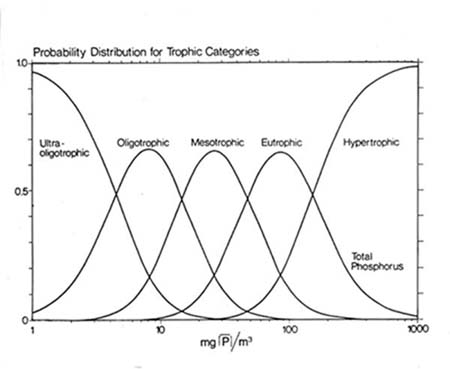
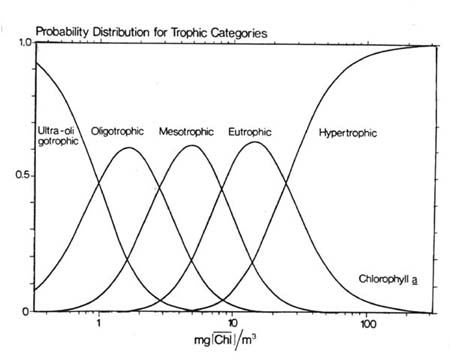
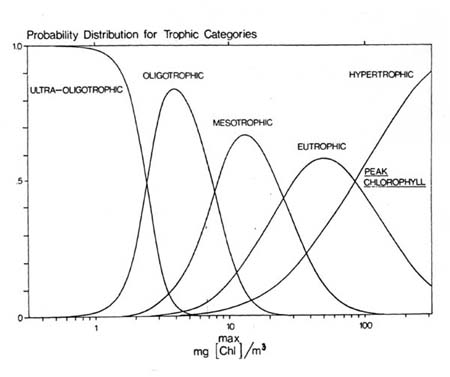
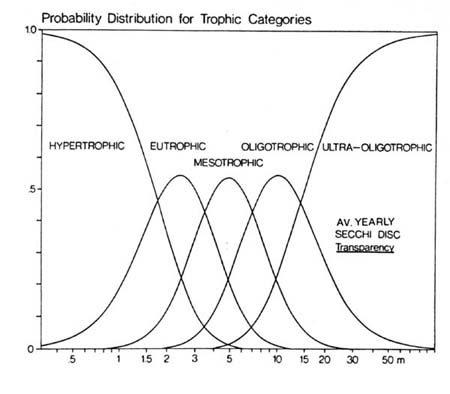
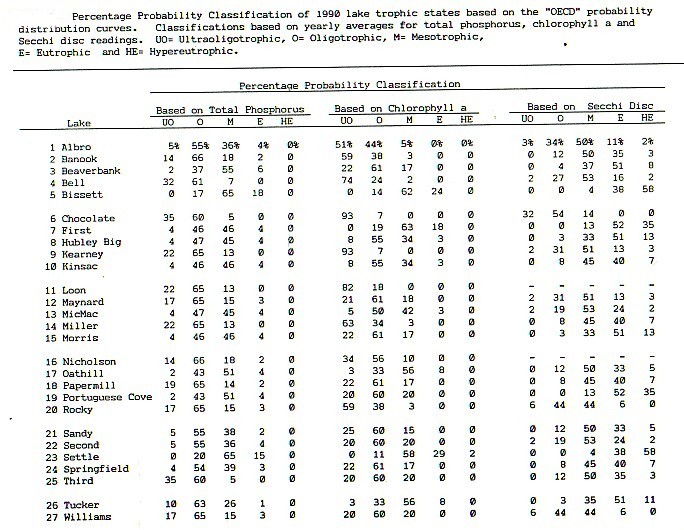
E. The importance of paleolimnology:
Of particular significance are the following two papers:-
Smol, 2010; and Korosi et al, 2012
Select references:-
- Korosi, J.B., Burke, , S.M., Thienpont, J.R., and Smol, J.P. 2012. Anomalous rise in algal production linked to lakewater calcium decline through food web interactions. Proc. R. Soc. B (2012) 279, 1210–1217.
- Smol, J.P. 2008. Pollution of Lakes and Rivers: A
Paleoenvironmental Perspective. 2nd ed. Blackwell Publishing, Oxford.
x,383 pp. ISBN-13: 978-1-4051-5913-5.
- Smol, J.P. 2010.
The power of the past: using sediments to track the effects of multiple
stressors on lake ecosystems. Freshwater Biology (2010), 55 (Suppl. 1),
43–59.
- Soil & Water Conservation Society of Metro Halifax: Paleolimnology Homepage
- Soil & Water Conservation Society of Metro Halifax: Lake Management Challenges: Multiple Stressors
- Soil & Water Conservation Society of Metro Halifax: Paleolimnology of lakes in Nova Scotia, Canada
F. Stressors and treatment efficiencies
(Note: Although some of the references are
dated, indicator sampling across HRM carried out by our society and
others have confirmed the ranges.)
(USEPA, 1976 [Source: Sartor and Boyd, 1972])
| Measured Pollutant | Particle size
|
|---|
| <43µ | | 43µ - 246µ | | >246µ
|
|---|
| (% by weight)
|
| TS | 5.9 | | 37.5 | | 56.5 |
| BOD5 | 24.3 | | 32.5 | | 43.2 |
| COD | 22.7 | | 57.4 | | 19.9 |
| VS | 25.6 | | 34.0 | | 40.4 |
| Phosphates | 56.2 | | 36.0 | | 7.8 |
| Nitrates | 31.9 | | 45.1 | | 23.0 |
| Kjeldahl Nitrogen | 18.7 | | 39.8 | | 41.5 |
| All heavy metals | | 51.2 | | 48.7 | |
| All pesticides | | 73 | | 27 | |
| PCB | | 34 | | 66 | |
(Drapper et al [Source: Kobringer, N.P.
1984. Volume I. Sources and Migration of Highway Runoff Pollutants-
Executive Summary. FHWA/RD-84/057. Federal Highway Administration,
Rexnord, EnviroEnergy Technology Center, Milwaukee, WI])
| Constituent | Primary Sources |
|---|
| Particulates | Pavement wear, vehicles, atmosphere, maintenance, snow/ice abrasives, sediment disturbance |
| Nitrogen, Phosphorus | Atmosphere, roadside fertiliser use, sediments |
| Lead | Leaded gasoline, tire wear, lubricating oil and grease, bearing wear, atmospheric fallout |
| Zinc | Tire wear, motor oil, grease |
| Iron | Auto body rust, steel highway structures, engine parts |
| Copper | Metal plating, bearing wear, engine parts, brake lining wear, fungicides and insecticides use |
| Cadmium | Tire wear, insecticide application |
| Chromium | Metal plating, engine parts, brake lining wear |
| Nickel | Diesel fuel and gasoline, lubricating oil, metal plating, brake lining wear, asphalt paving |
| Manganese | Engine parts |
| Bromide | Exhaust |
| Cyanide | Anticake compound used to keep deicing salt granular |
| Sodium, Calcium | De-icing slats, grease |
| Chloride | De-icing salts |
| Sulphate | Roadway beds, fuel, de-icing salts |
| Petroleum | Spills, leaks, blow-by motor lubricants, antifreeze, hydraulic fluids, asphalt surface leachate |
| PCBs, pesticides | Spraying of highway right of ways, atmospheric deposition, PCB catalyst in synthetic tires |
| Pathogenic bacteria | Soil litter, bird droppings, trucks hauling livestock/stockyard waste |
| Rubber | Tire wear |
| Asbestos* | Clutch and brake lining wear |
* No mineral asbestos has been identified in runoff, however some breakdown products of asbestos have been measured
(Drapper et al [Source: Driscoll, E.,
Shelley, P.E., and Strecker, E.W. 1990. Pollutant Loadings and Impacts
from Highway Stormwater Runoff. Volumes I-IV. FHWA/RD-88-006-9, Federal
Highway Administration, Woodward-Clyde Consultants, Oakland, CA])
| Pollutant | Urban (ADT> 30,000) | Rural (ADT< 30,000) |
|---|
| (µg/l) | (µg/l) |
|---|
| TSS (Total Suspended Solids) | 142,000 | 41,000 |
| VSS (Volatile Suspended Solids) | 39,000 | 12,000 |
| TOC (Total Organic Carbon) | 25,000 | 8,000 |
| COD (Chemical Oxygen Demand) | 114,000 | 49,000 |
| NO3/NO2 (Nitrate + Nitrite) | 760 | 570 |
| TKN (Total Kjeldahl Nitrogen) | 1,830 | 870 |
| Phosphorus as PO4 | 400 | 160 |
| Cu (Total Copper) | 54 | 22 |
| Pb (Total Lead) | 400 | 80 |
| Zn (Total Zinc) | 329 | 80 |
(Herr and Harper [Source: Harper, H.H. 1988.
Effects of Stormwater Management Systems on Groundwater Quality. Final
Report for Project SM 190, submitted to the Florida Department of
Environmental Regulation.])
| Parameter | Typical Distribution (%) |
|---|
| Dissolved | Particulate |
|---|
| Total N | 40 | 60 |
| Total P | 50 | 50 |
| TSS | 0 | 100 |
| BOD | 60 | 40 |
| Total Cd | 70 | 30 |
| Total Cr | 65 | 35 |
| Total Cu | 70 | 30 |
| Total Ni | 70 | 30 |
| Total Pb | 25 | 75 |
| Total Zn | 35 | 65 |
Unit Urban Phosphorus Export Coefficients (kg/ha.yr) (Vokey, 1998)
| Local watershed | Storm sewer catchment area (ha) | TP Export Coefficient (kg/ha.yr)
|
|---|
| Settle Lake | 7.3 | 0.53
|
| Bissett Lake | 57.6 | 0.57
|
Rate of settling in pure, still water (temp=10oC, sp. gravity of particles=2.65, shape of particles=spherical) (Welch, 1935)
| Material | Diameter (mm) | Hydraulic subsiding value (mm/sec) | Time required to settle 1 ft.
|
|---|
| Gravel | 10.0 | 1000.0 | 0.3 sec
|
| Coarse sand | 1.0 | 100.0 | 3.0 sec
|
| Fine sand | 0.1 | 8.0 | 38.0 sec
|
| Silt | 0.01 | 0.154 | 33.0 min
|
| Bacteria | 0.001 | 0.00154 | 55.0 hr
|
| Clay | 0.0001 | 0.0000154 | 230.0 days
|
| colloidal particles | 0.00001 | 0.000000154 | 63 years
|
Comparison of Estimated Removal Efficiencies (cf. Herr and Harper)
| Structure | Removal Efficiencies % |
|---|
| Litter | Debris | Sediments |
|---|
| Vortechs System | ?(10-50) | ?(10-50) | 60-80 |
| Stormceptor | ?(10-50) | ?(10-50) | 60-80 |
| CDS | 98 | 98 | ?(10-50) |
| Baffle Box | ?(10-50) | ?(10-50) | 60-80 |
Estimated Net Mass Reduction in Stormwater Constituents Achieved Based on 70% TSS Removal (cf. Herr and Harper)
| Parameter | Estimated Annual Mass Load Reduction (%) |
|---|
| Total N | 30 |
| Total P | 25 |
| TSS | 70 |
| BOD | 20 |
| Cadmium | 15 |
| Chromium | 18 |
| Copper | 15 |
| Lead | 38 |
| Nickel | 15 |
| Zinc | 33 |
Adequate sizing is imperative:
Following is a listing of the wetlands that
were researched for their ability to treat stormwater runoff as well as
a map of the USA showing their location. Some of the constructed
wetlands are located in regions with harsher climate and/or more
intensive snow cover than in Nova Scotia (cf. Strecker et al., 1992).
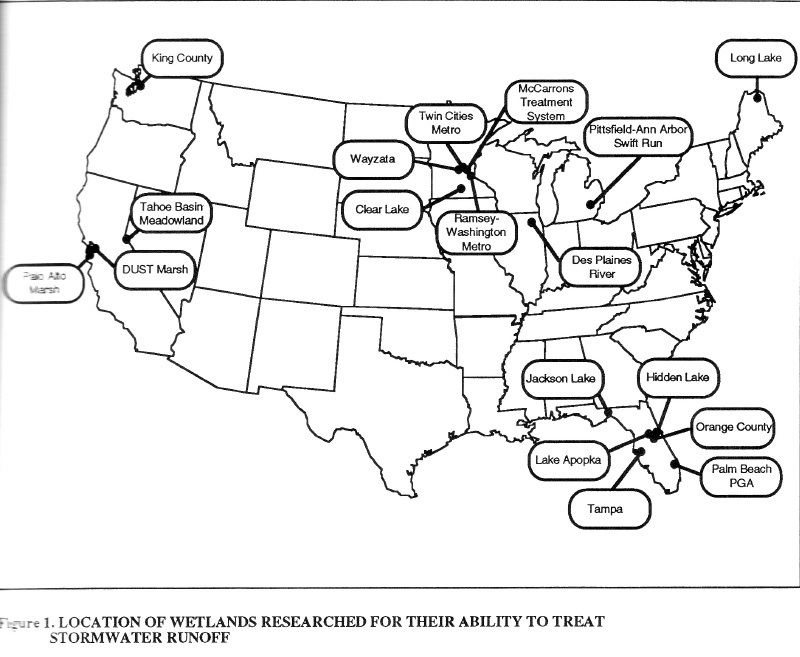
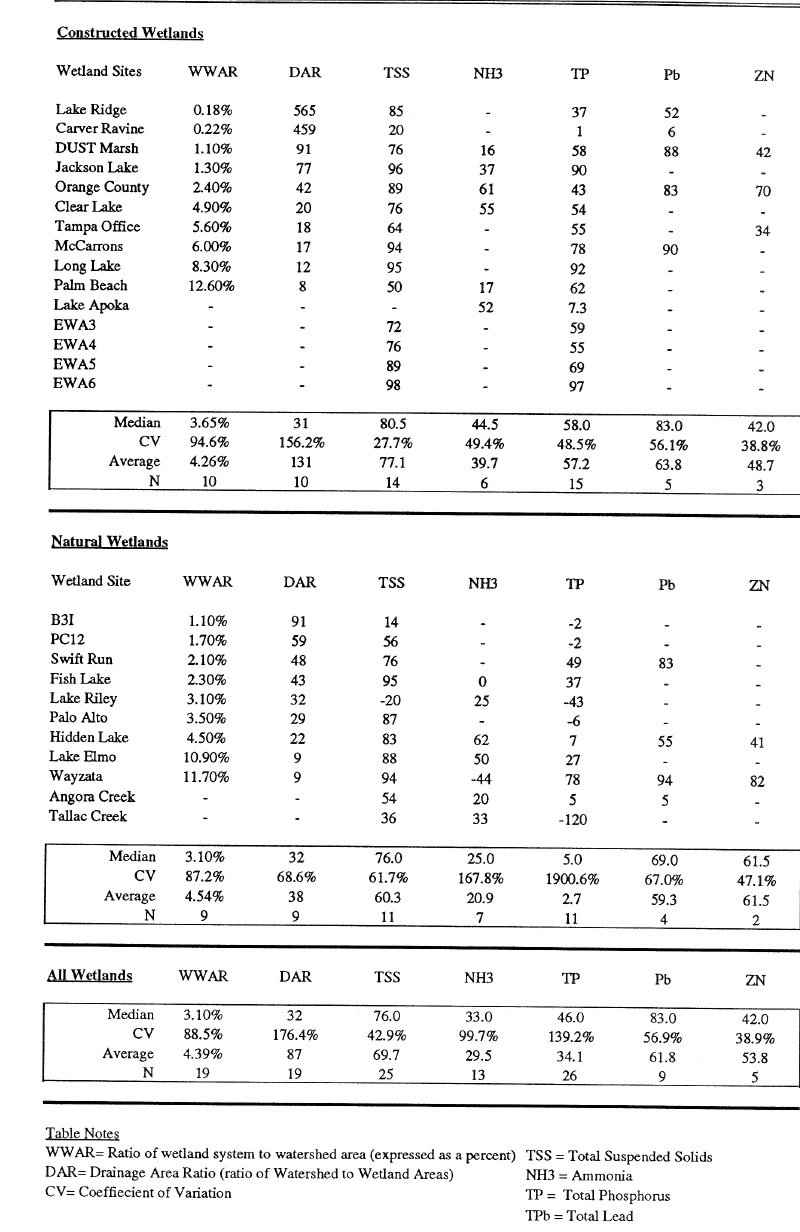
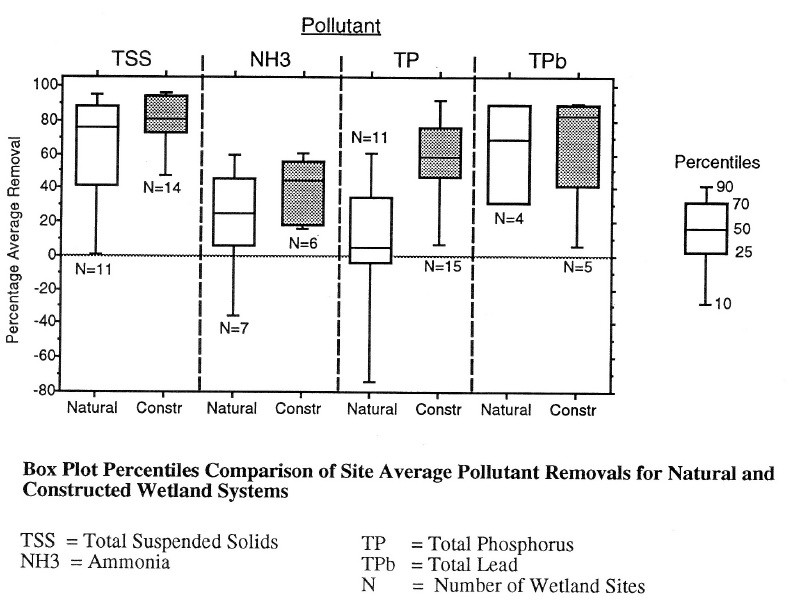
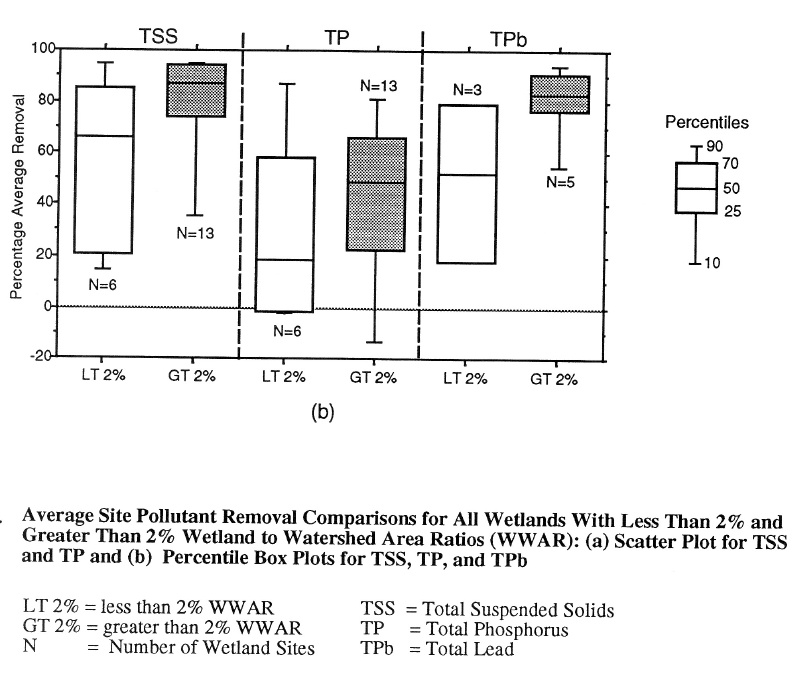
Select references:-
- Drapper, D., Tomlinson, R., and
Williams, P. An Investigation of the Quality of Stormwater Runoff From
Road Pavements; A South-East Queensland Case Study. School of
Environmental Engineering, Griffith University, Nathan Campus,
Queensland, Australia. 8p.
- Herr, J.L., and Harper, H.H. Removal of Gross Pollutants From
Stormwater Runoff Using Liquid/Solid Separation Structures.
Environmental Research & Design, Inc., Orlando, FL. 14p.
- Sartor, J.D., and Boyd, G.B. 1972. Water Pollution Aspects of Street Surface Contaminants. USEPA. EPA-R2-72-081.
- Schueler, T., and Shepp, D. 1993. The quality of trapped
sediments and pool water within oil-grit separators in suburban
Maryland. MDE Urban Hydrocarbon Study, Maryland Dept. of the
Environment.
- Scott, R., Hart, W., Mandaville, S., and Lowe, J. 2003.
Selection of a Phosphorus Loading Model for Nova Scotia, Phase I. For:
Nova Scotia Water Quality Objective and Model Development Steering
Committee and Nova Scotia Dept. of Environment and Labour. 85p
- USEPA. 1976. Areawide Assessment Procedures Manuals. Vols.
I-III. Municipal Environ. Res. Lab., Cincinnati, Ohio.
EPA-600/9-76-014.
- Vokey, J. 1998. Development of Unit Urban Phosphorus Export
Coefficients in the local watersheds of 2 Mesotrophic Lakes within the
Halifax Regional Municipality (HRM), NS, Canada. Project-C. (2 Lakes:
Settle and Bissett). Soil & Water Conservation Society of Metro
Halifax. viii, 51p.
- Welch, P. S. 1935. Limnology. McGraw-Hill Book Co., Inc. 471p.
G. Buffer Strips
A "Standard Buffer"
A "Standard Buffer" is defined as a
particular length of site capable of trapping 953 kg. of sediment
per year (USDA, 1977 [Source: Wilson, 1967]); Summary of curve numbers
by land use (Panuska and Schilling, 1993 [Source: USDA, 1986]);
Hydrologic soil groups (USDA, 1986); and nomograph parameters values
from Nova Scotia (Beke and Webb, 1978)
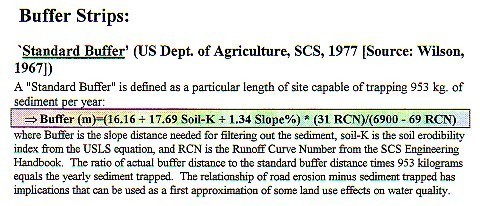
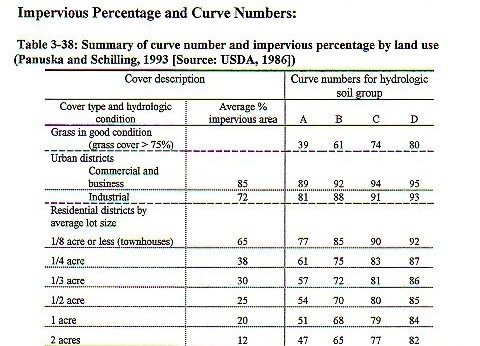

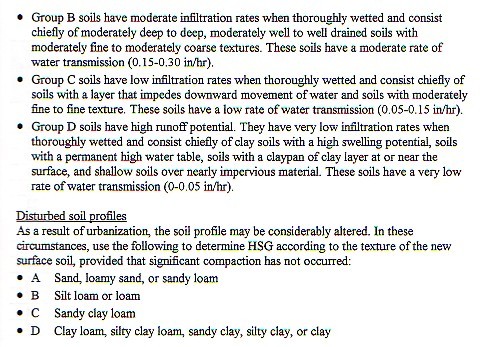
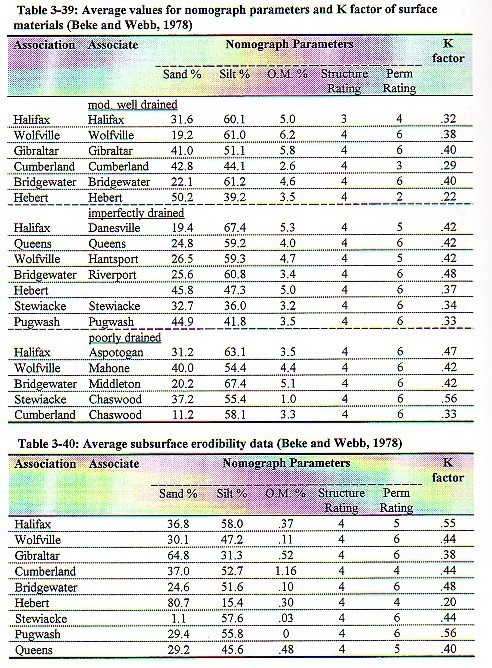
Canada's interim narrative on regression analysis between stream buffer widths and average TN and TP concentrations:-
![[Img-howell2003_1.jpg]](http://lakes.chebucto.org/INFO/BUFFERS/PIC/howell2003_1.jpg)
![[Img-howell2003_2.jpg]](http://lakes.chebucto.org/INFO/BUFFERS/PIC/howell2003_2.jpg)
Select references:-
- Beke, G.J., and Webb, K.T. 1978. A
survey of the soil-erodibility (K) factor for representative soils from
the Shubenacadie River-Stewiacke Corridor area. Tech. Rpt. #3. The
Shubenacadie-Stewiacke River Basin Board. 25p.
- Howell, G. 2003. Environment Canada.
- Panuska, J.C., and J.G. Schilling. 1993. Consequences of
Selecting Incorrect Hydrologic Parameters When Using the Walker Pond
Size and P8 Urban Catchment Models. Lake and Reserv. Manage. 8(1):
73-76.
- U.S. Dept. of Agriculture, SCS. 1977. Handout on Erosion Control. Env. Servs. Div.
- U.S. Dept. of Agriculture, SCS. 1986. Urban hydrology for small watersheds- Technical Release No. 55 (Sec. Ed.). 160p.
- Wilson, L.G. 1967. Sediment Removal from Flood Water by Grass Filtration. Tans. ASAE.
H. Monitoring of the effluent plume from an onsite sewage disposal system
During the last decade or longer, claims and
counter-claims have been made worldwide by many inclusive of several
professional consultants, regulators and others regarding the longevity
and effectiveness of onsite disposal systems.
During the summer of 2000, an
excellent 2-page article was published in the USEPA (United States
Environmental Protection Agency)-sponsored Small Flows Quarterly,
titled "Monitoring Effluent Plumes". The article was by David Pask MEng PEng, Engineering Scientist with the USEPA’s Small Flows Clearinghouse at the University of West Virginia.
It was indeed the brilliant
David Pask PEng who had developed the contour beds. It was his Master’s
Degree project (1983) under the expert supervision of the now retired Prof. Dan Thirumurthi PhD PEng at TUNS, Halifax.
One can note the extreme
details and monitoring that is necessary in order to establish with
confidence the plume progression and the resultant pollutant
dispersion/sorption over the years/decades. Further, numerous sites
have to be monitored in order to be statistically relevant in almost
every sub-watershed!
In addition, lab analysis of
soil adsorption properties for phosphorus will not be relevant in the
real field situation over time! This is because of the existence of
paths of differential conductivity as well as the presence of
macropores in the soil.
Further, it will be difficult
to simulate saturated and unsaturated conditions in the laboratory on
temporal/spatial scales which exist in the field among other problems.
An informative email from David Pask MEng PEng:-
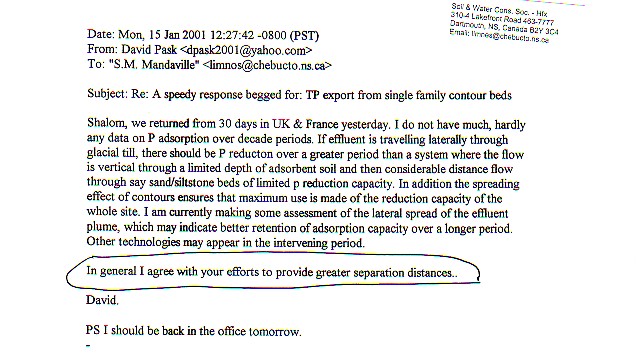
![[Img-monitoring1]](http://lakes.chebucto.org/INFO/SEWAGE/ONSITES/PIC/monitoring1.jpg)
![[Img-monitoring2]](http://lakes.chebucto.org/INFO/SEWAGE/ONSITES/PIC/monitoring2.jpg)
I. A lead example of the methodology to assess the downstream impacts of a proposed STP:
For several years there has been wide
concern among our member-professionals with respect to the long term
impacts of STPs (sewage/wastewater treatment plants). The probable
impact of an STP on a freshwater lake can be quite significant,
especially during the summer months when the lakes do not flush
appreciably. While the design of an STP is
the domain of a professional engineer, the professional who has the
credibility in the scientific evaluation is a limnologist/professional
lake manager.
Inserted below is a 12-page
published paper of a leading chemical limnologist, Joe Kerekes PhD,
Scientist-Emeritus with Environment Canada Atlantic, Dartmouth. Dr.
Kerekes was also one of the leading scientists who headed the
international OECD (Organization for Economic Co-Operation &
Development) peer consensus standards-development.
In this published paper, Dr.
Kerekes carries out an intensive scientific analysis of the impact of a
proposed secondary-level package STP prior to its installation at a
development site which drains into Freshwater Lake, Cape Breton
Highlands National Park. He warns against secondary treatment as that
would result in the Freshwater Lake becoming `Mesotrophic’, its
management objective being `Oligotrophy’!
![[Img- Kerekes_1983-1]](http://lakes.chebucto.org/TPMODELS/NOTES/PIC/kerekes_1983-1.jpg)
![[Img- Kerekes_1983-2]](http://lakes.chebucto.org/TPMODELS/NOTES/PIC/kerekes_1983-2.jpg)
![[Img- Kerekes_1983-3]](http://lakes.chebucto.org/TPMODELS/NOTES/PIC/kerekes_1983-3.jpg)
![[Img- Kerekes_1983-4]](http://lakes.chebucto.org/TPMODELS/NOTES/PIC/kerekes_1983-4.jpg)
![[Img- Kerekes_1983-5]](http://lakes.chebucto.org/TPMODELS/NOTES/PIC/kerekes_1983-5.jpg)
![[Img- Kerekes_1983-6]](http://lakes.chebucto.org/TPMODELS/NOTES/PIC/kerekes_1983-6.jpg)
![[Img- Kerekes_1983-7]](PIC/kerekes_1983-7.jpg)
![[Img- Kerekes_1983-8]](http://lakes.chebucto.org/TPMODELS/NOTES/PIC/kerekes_1983-8.jpg)
![[Img- Kerekes_1983-9]](http://lakes.chebucto.org/TPMODELS/NOTES/PIC/kerekes_1983-9.jpg)
![[Img- Kerekes_1983-10]](http://lakes.chebucto.org/TPMODELS/NOTES/PIC/kerekes_1983-10.jpg)
![[Img- Kerekes_1983-11]](http://lakes.chebucto.org/TPMODELS/NOTES/PIC/kerekes_1983-11.jpg)
![[Img- Kerekes_1983-12]](http://lakes.chebucto.org/TPMODELS/NOTES/PIC/kerekes_1983-12.jpg)
J. Shallow Lakes
Traditionally, limnology is mostly concerned
with lakes that stratify in summer. The impact of macrophytes on the
community is relatively small in such lakes, as plant growth is
restricted to a relatively narrow marginal zone.
These lakes are not expected to
stratify for long periods in summer. This type of lake, where the
entire water column is frequently mixed, is also referred to as
polymictic. The intense sediment-water interaction and the potentially
large impact of aquatic vegetation makes the functioning of shallow
lakes different from that of their deep counterparts in many aspects.
Shallow lakes are defined as
lakes where the euphotic zone extends over the bottom. Simply, the
euphotic zone is defined as the depth at which the light intensity of
the photosynthetically active spectrum (400-700 nm) equals 1% of the
subsurface light intensity.
Select references:-
- Jones, R.I. 2005. Limnology of humic
waters: special theme or universal framework? Plenary lecture, XXIX
Congress, 2004, International Association of Theoretical and Applied
Limnology. Verh. Internat. Verein. Limnol. 29(1):51-60.
- Soil & Water Conservation Society of Metro Halifax: Shallow Lakes
- Soil & Water Conservation Society of Metro Halifax: Eutrophication of Waters (OECD)
- Vollenweider, R.A., and Kerekes, J. 1982. Eutrophication of
waters. Monitoring, assessment and control. OECD Cooperative programme
on monitoring of inland waters (Eutrophication control), Environment
Directorate, OECD, Paris. 154 p.
- Wetzel, R.G., and Likens, G.E. 2000. Limnological Analyses.
3rd Ed. Springer, New York. xv, 429 pp.
Wetzel, R.G. 2001. Limnology. Lake and River Ecosystems. Third Ed.
Academic Press, San Diego. xvi, 1006 pp. ISBN 0-12-744760-1.
K. Sandy Lake model with field data (4th vers.)
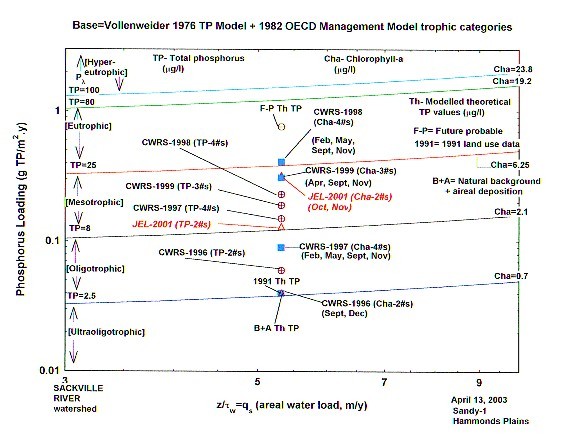
L. Additional info on us
The combined fiscal value of the research of
this society and the signatory’s personal IP, i.e., intellectual
property, of the lakes/ponds within HRM is approximately in the three
(3) million dollar range if conducted as paid scientist-consultants.
Our additional research/studies:-
We have completed predictive modelling of several parameters (not
phosphorus alone) of one thousand five hundred (1,500) lakes/ponds in
four (4) counties of Nova Scotia, and most of HRM is covered.
Indeed, our `multivariate
models’ were able to predict some of the existing visible problems,
e.g., weed infestations, in some lakes. As heads up, we had sent
numerous cautionary emails and syntheses to provincial as well as
municipal authorities.
We have received accolades from some leading international governments and scientific authorities.
Select professional staff of
HRM (and it’s predecessor municipal units) and some of its leading
consultants contacted us over the last two decades seeking our advice
and our scientific studies, generally on a pro bono basis.
We also receive requests from stakeholders, outside of our membership, asking for our assistance, almost every year.
The scientists we cite in this submission are mostly among the stalwarts of international limnology.


We salute the Chebucto Community Net (CCN) of Halifax, Nova Scotia, Canada for hosting our web site, and we applaud its volunteers for their devotion in making `CCN' the best community net in the world!

 Bacterial
Source Tracking (BST) is a state-of-the-art methodology that is being
used in advanced jurisdictions to determine the sources of fecal
bacteria in environmental samples (e.g. from human, livestock, or
wildlife origins). BST methodology has been described as having the
ability to turn nonpoint sources into point sources. BST is also called
Microbiological Source Tracking (MST), fecal source tracking, or fecal
typing.
Bacterial
Source Tracking (BST) is a state-of-the-art methodology that is being
used in advanced jurisdictions to determine the sources of fecal
bacteria in environmental samples (e.g. from human, livestock, or
wildlife origins). BST methodology has been described as having the
ability to turn nonpoint sources into point sources. BST is also called
Microbiological Source Tracking (MST), fecal source tracking, or fecal
typing.
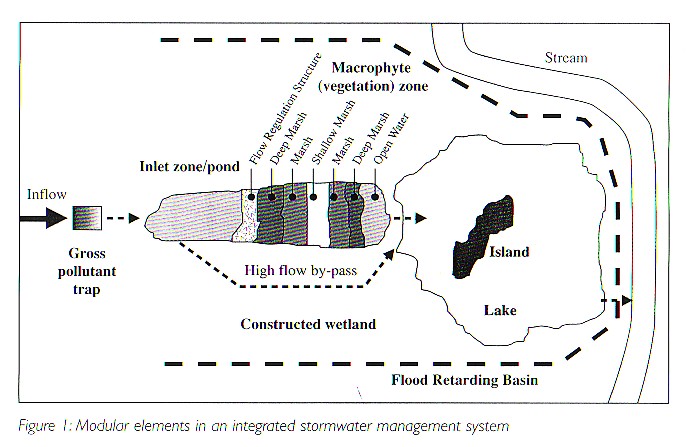
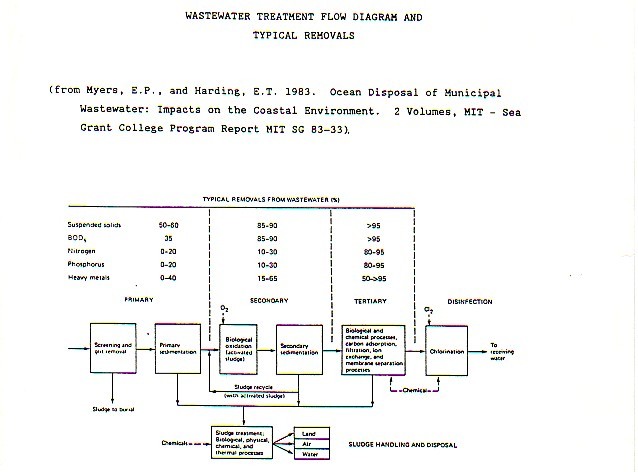
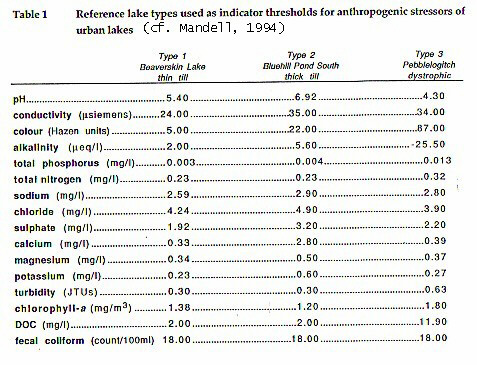














![[Img-howell2003_1.jpg]](http://lakes.chebucto.org/INFO/BUFFERS/PIC/howell2003_1.jpg)
![[Img-howell2003_2.jpg]](http://lakes.chebucto.org/INFO/BUFFERS/PIC/howell2003_2.jpg)

![[Img-monitoring1]](http://lakes.chebucto.org/INFO/SEWAGE/ONSITES/PIC/monitoring1.jpg)
![[Img-monitoring2]](http://lakes.chebucto.org/INFO/SEWAGE/ONSITES/PIC/monitoring2.jpg)
![[Img- Kerekes_1983-1]](http://lakes.chebucto.org/TPMODELS/NOTES/PIC/kerekes_1983-1.jpg)
![[Img- Kerekes_1983-2]](http://lakes.chebucto.org/TPMODELS/NOTES/PIC/kerekes_1983-2.jpg)
![[Img- Kerekes_1983-3]](http://lakes.chebucto.org/TPMODELS/NOTES/PIC/kerekes_1983-3.jpg)
![[Img- Kerekes_1983-4]](http://lakes.chebucto.org/TPMODELS/NOTES/PIC/kerekes_1983-4.jpg)
![[Img- Kerekes_1983-5]](http://lakes.chebucto.org/TPMODELS/NOTES/PIC/kerekes_1983-5.jpg)
![[Img- Kerekes_1983-6]](http://lakes.chebucto.org/TPMODELS/NOTES/PIC/kerekes_1983-6.jpg)
![[Img- Kerekes_1983-7]](PIC/kerekes_1983-7.jpg)
![[Img- Kerekes_1983-8]](http://lakes.chebucto.org/TPMODELS/NOTES/PIC/kerekes_1983-8.jpg)
![[Img- Kerekes_1983-9]](http://lakes.chebucto.org/TPMODELS/NOTES/PIC/kerekes_1983-9.jpg)
![[Img- Kerekes_1983-10]](http://lakes.chebucto.org/TPMODELS/NOTES/PIC/kerekes_1983-10.jpg)
![[Img- Kerekes_1983-11]](http://lakes.chebucto.org/TPMODELS/NOTES/PIC/kerekes_1983-11.jpg)
![[Img- Kerekes_1983-12]](http://lakes.chebucto.org/TPMODELS/NOTES/PIC/kerekes_1983-12.jpg)
